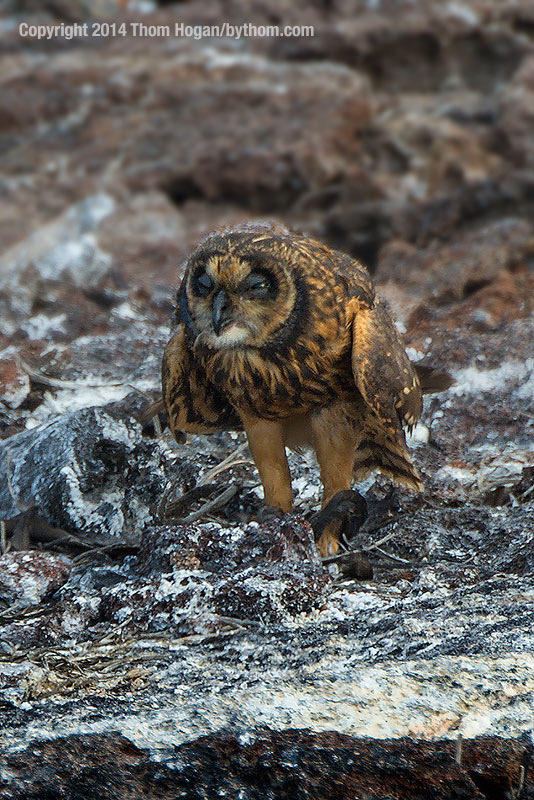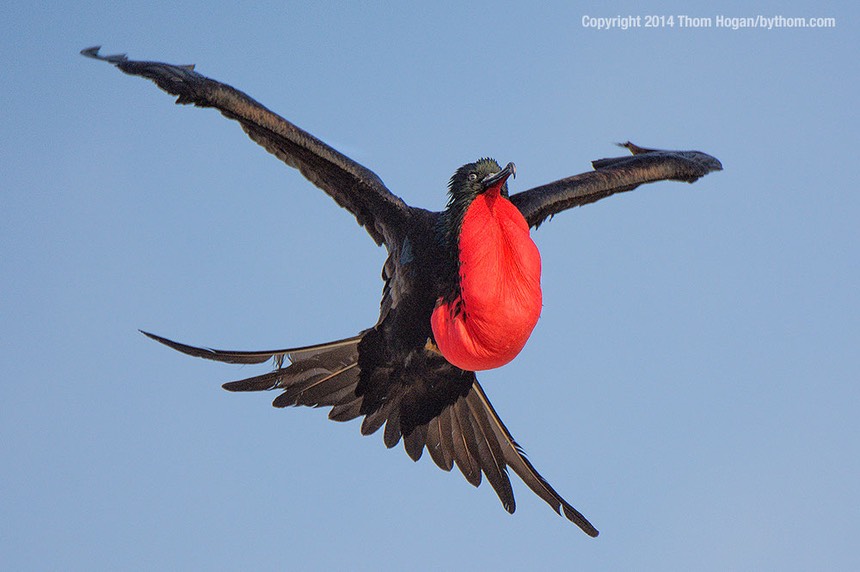
D7100, 240mm, f/8
I wanted to follow up on several things I wrote last month about focus when I came back from the Galapagos. This full frame from a D7100 is very illustrative of the focus issues that come up with birds in flight (BIF).
First, let me describe the situation: this blue-footed booby is flying alongside a cliff at relatively high speed (certainly at least 15mph, likely more). I’m tracking the bird from the right to this position. Since I’m using the 80-400mm, I also started at 400mm when the bird is far to my right and zoomed out as the bird approached. Why? Because I’m trying to keep the bird as big as possible so that my focus sensors will really see it.
Note the wing positions. The booby isn’t flying an exact straight line: it’s veering a bit left and right as it goes, which makes keeping the camera oriented on it correctly tough work. So much so that the focus sensor isn’t perfectly set here.
Normally when I’m doing BIF shooting like this where the bird patterns are predictable I’d usually have the camera set to the left AF sensor (because the head is on the left). Because the background is relatively plain sky, I’d be in either 9-point or 21-point dynamic AF-C. In this case I was alternating back and forth between shooting the big birds (bodies, albatross) that were flying a more fixed pattern with shooting small birds flying erratic patterns in all directions at the cliff edge, so my selected AF sensor is actually the center one, and I’m in 9-point to keep the focus area tight. Note what that did here: because I’m aimed just a little high, the focus sensor is actually seeing some of the bird’s left wing (I’d generally want it on the body in the this situation, though I really want it on the head; but the body is pretty much at the same plane as the head). I’m at f/8 to give me a little DOF to cover such situations.
Still, the Nikon AF sensors are taller (and in the case of the center sensor, wider) than the viewfinder indicates. So some of the sensor is on the body, some on the wing. What does the camera do in that situation? We don’t know, because Nikon has never documented or discussed that. However, one of the changes that seems to have been made since the film era is that Closest Subject Priority (CSP) is no longer used. It appears to me that the camera is “voting” on the subject based upon how much subject it sees at different distances on the sensor.
To understand that, you have to know that each individual AF sensor is actually comprised of multiple smaller individual detection units. To keep things simple, let’s say we’re dealing with an AF sensor that’s a vertical line and comprised of 10 stacked sub-cells. If it reports 6 sub-cells at one distance and 4 at another, what should happen? Easy: it should pick the distance covered by the 6 sub-cells. But what if the vote is 5 and 5? This is one area where CSP came into play in the Olden Days of Autofocus. Simple: the closest distance was used. I do not believe that’s the case anymore. If anything, I believe that Nikon DSLRs now prioritize the further distance over the closer distance in such instances. But that’s anecdotal and experiential; there could be something else going on I’m not aware of.
When I wrote that the AF sensor indicators in the viewfinder were a lie in one of my articles last month, this is one area where newcomers get completely bamboozled by the Nikon AF system. If you don’t know the actual position and size of the sensors, you may simply be thinking the camera is focusing in one place when it isn’t. The smaller your subject’s focus plane is in the viewfinder, the more likely that is. Which is one reason why I always want the right lens so that I can fill the frame with my subject, even small flying birds. Sure, it’s incredibly difficult to keep the frame locked on fast moving animals when they fill the frame (especially if you hold down the shutter release and rattle off 8 fps ;~), but it’s do-able with practice, and I believe it’s necessary to get the best results. The photo, above, is about as small as I want a booby in my frame when I’m shooting it in motion. The smaller it is in the frame, the tougher time I’ll have at keeping it in focus. (Aside: when boobies dive for food in the water, they tuck their wings and turn into a “stick” that’s incredibly difficult to keep focus on.)
The problem I have with the mirrorless phase detect systems in this instance is similar: the focus positions used in the mirrorless cameras are actually very small, smaller than the viewfinder indicators (opposite of the DSLRs). Getting the right focus sensor onto the right part of a fast moving object is near impossible on these cameras, so you’re always going to get a bit of the luck of the draw. For a subject that is relatively flat coming directly at you (human), that’s okay. For the way I was shooting these birds it was exceedingly frustrating, as even if I could get the focus on the head as I first acquired the bird, the fact that the bird is changing angle to me meant that I was getting slightly random focus positions as the bird flew by. And in some cases, getting that little focus sensor on “sky” for even a moment usually meant complete failure to track.
Next up we have “when do I press the shutter release”? Remember, I was tracking this bird far to the right, when it was nearly head on to me. The temptation amongst amateurs is to press the release early and let a rapid frame rate capture all the possible positions of the bird (hopefully in focus and framed right, though both of those things tend not to happen if there’s any irregular motion in the bird’s path ;~). Nope. Wrong approach.
Look at published bird images. Each bird tends to have interesting and unique wing positions (and sometimes body positions) that are preferable to others. Those are the shots you want, and you don’t need 8 fps to get them. Instead you need to recognize them and take a single shot with the system focused and framed properly ;~). I waited until this bird was adjacent to my position on the cliff to hit the release. As it was, he still managed to turn his head slightly, which makes the shot not quite as good as it could be (if the head is turned, towards me would be better). I do sometimes use continuous shooting starting with the shot I want. I note that this was the second frame of a three frame sequence I took.
There’s much, much more going on here that I could write about. For example, what’s my body position? Why, it’s facing the bird at this moment in time with my legs slightly spread. Yes, that means that I was twisted to the right at the hips when I first acquired the bird, then followed him by untwisting to my steadiest body position before taking the shot.
The interesting thing about shooting BIF is that so many little technique things all turn out to be very important to the final result. Curiously, one of the things that everyone seems to have problems with—exposure—isn’t. This shot was Sunny 16. So was every other shot of the birds flying along that cliff. You didn’t even need an exposure meter to get that right. As my friend Chas Glatzer says: shoot the light.
So how would I really want to have been framed on this bird in a perfect world? Like this:

As you can tell, I’m not far off in the original from where I wanted to be. Had I been at this position, the focus would have been a little tighter to where I wanted it, too. But that’s exactly why I go places where I can practice this from time to time. You don’t get better unless you practice.
